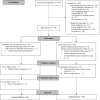Aerobic and Resistance Exercise Improves Shoulder Function in Women Who Are Overweight or Obese and Have Breast Cancer: A Randomized Controlled Trial
- PMID: 31309977
- PMCID: PMC6821226
- DOI: 10.1093/ptj/pzz096
Aerobic and Resistance Exercise Improves Shoulder Function in Women Who Are Overweight or Obese and Have Breast Cancer: A Randomized Controlled Trial
Abstract
Background: Adverse upper limb musculoskeletal effects occur after surgical procedures and radiotherapy for breast cancer and can interfere with activities of daily living.
Objective: The objective of this study was to examine the effects of a 16-week exercise intervention on shoulder function in women who are overweight or obese and have breast cancer.
Design: This study was a randomized controlled trial.
Setting: The study was performed at the Division of Biokinesiology and Physical Therapy at the University of Southern California.
Participants: One hundred women with breast cancer were randomly allocated to exercise or usual-care groups. The mean (SD) age of the women was 53.5 (10.4) years, 55% were Hispanic white, and their mean (SD) body mass index was 33.5 (5.5) kg/m2.
Intervention: The 16-week exercise intervention consisted of supervised, progressive, moderate to vigorous aerobic and resistance exercise 3 times per week.
Measurements: Shoulder active range of motion, isometric muscular strength, and patient-reported outcome measures (including Disabilities of the Arm, Shoulder, and Hand and the Penn Shoulder Scale) were assessed at baseline, after the intervention, and at the 3-month follow-up (exercise group only). Differences in mean changes for outcomes were evaluated using mixed-model repeated-measures analysis.
Results: Compared with the usual-care group, the exercise group experienced significant increases in shoulder active range of motion (the mean between-group differences and 95% confidence intervals (CIs) were as follows: shoulder flexion = 36.6° [95% CI = 55.2-20.7°], external rotation at 0° = 23.4° [95% CI = 31.1-12.5°], and external rotation at 90° = 34.3° [95% CI = 45.9-26.2°]), improved upper extremity isometric strength, and improved Disabilities of the Arm, Shoulder, and Hand and Penn Shoulder Scale scores.
Limitations: Limitations include a lack of masking of assessors after the intervention, an attention control group, and statistical robustness (shoulder function was a secondary end point).
Conclusions: A 16-week exercise intervention effectively improved shoulder function following breast cancer treatment in women who were overweight or obese, who were ethnically diverse, and who had breast cancer.
Trial registration: ClinicalTrials.gov NCT01140282.
© 2019 American Physical Therapy Association.
Figures

References
-
- National Cancer Institute Surveillance, Epidemiology, and End Results Program Cancer Stat Facts: female breast cancer SEER Cancer Statistics Review. https://seer.cancer.gov/statfacts/html/breast.html. Accessed January 4, 2018.
-
- American Cancer Society Cancer facts and figures 2017 American Cancer Society .https://www.cancer.org/research/cancer-facts-statistics/all-cancer-facts-figures/cancer-facts-figures-2017.html. Accessed December 15, 2017.
-
- Lee TS, Kilbreath SL, Refshauge KM, Herbert RD, Beith JM. Prognosis of the upper limb following surgery and radiation for breast cancer. Breast Cancer Res Treat. 2008;110:19–37. - PubMed
-
- McNeely ML, Binkley JM, Pusic AL, Campbell KL, Gabram S, Soballe PW. A prospective model of care for breast cancer rehabilitation: postoperative and postreconstructive issues. Cancer. 2012;118:2226–2236. - PubMed

